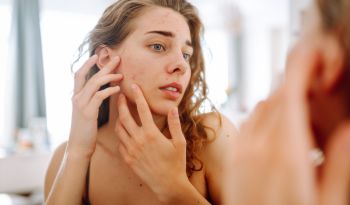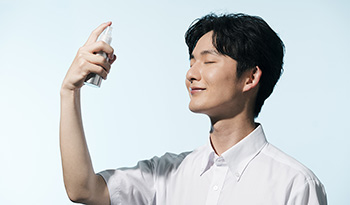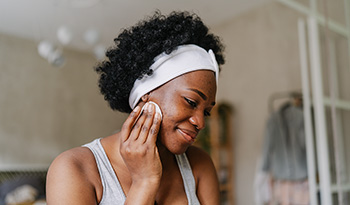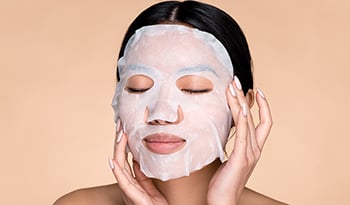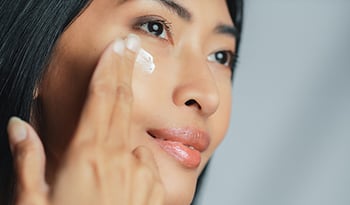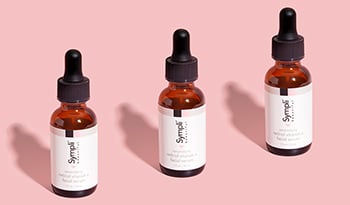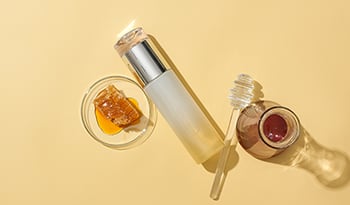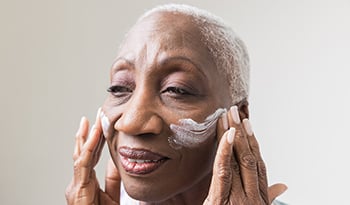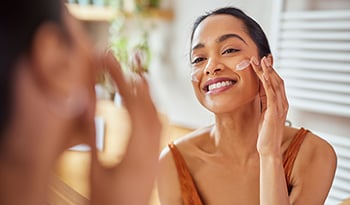Come combattere l'acne in modo naturale

Se c'è un problema medico che affligge gli adolescenti e i giovani adulti più di ogni altro, questo è l'acne vulgaris, il termine medico per indicare l'acne o, semplicemente, la condizione di avere troppi brufoli. L'acne è causata da un eccesso di sebo—una secrezione oleosa prodotta dalle ghiandole sebacee’della pelle—e da cellule morte che ostruiscono i follicoli piliferi. Il risultato sono “scoppi” che spesso compaiono sul viso, ma possono comparire anche su collo, schiena, petto e spalle.
Perché alcune persone soffrono di acne mentre altre mantengono una pelle pulita per tutta la pubertà e la giovane età adulta? Le ragioni sono numerose, ma la genetica gioca un ruolo importante insieme all'exposome—la somma delle esposizioni ambientali di una persona’tra cui l'alimentazione, lo stile di vita, le condizioni lavorative, gli agenti inquinanti, i farmaci assunti e il clima.
In generale, i ragazzi tendono a essere più colpiti dall'acne rispetto alle ragazze, ma questa condizione può essere devastante per chiunque debba affrontarla. L'innalzamento dei livelli di testosterone, che i ragazzi sperimentano durante la pubertà, potrebbe essere la causa, mentre anche la resistenza all'insulina e il pre-diabete aumentano il rischio. Sebbene i ragazzi siano più colpiti durante l'adolescenza, alcune donne sono colpite ben oltre l'adolescenza con l'acne ormonale scatenata dal ciclo mestruale e da condizioni come la sindrome dell'ovaio policistico.
Mentre la maggior parte dei casi di acne viene trattata dal medico di base o dal pediatra, a volte i pazienti vengono indirizzati a un dermatologo per opzioni di trattamento più aggressive, tra cui farmaci topici e orali, come retinoidi, acidi, pillole anticoncezionali e antibiotici. Fortunatamente, esistono anche approcci non farmacologici che si possono adottare per ridurre l'acne, indipendentemente dall'età.
Rimuovi le tossine
Ci sono alcune cose che puoi fare per eliminare le tossine dal tuo corpo. Ripulire la tua dieta, evitare gli alimenti processati, eliminare il mercurio dalla bocca, migliorare la salute dell'intestino, curare il fegato e ottimizzare la funzione renale possono migliorare la tua salute generale e, in definitiva, la tua pelle. Anche il fumo di tabacco sembra essere un fattore di rischio per l'acne— vaping compreso.
Ripulisci la tua dieta
Alcuni studi dimostrano che i latticini, come il latte, aumentano la produzione di sebo stimolando l'ormone IGF-1 e, quindi, aumentano il rischio di acne. Inoltre, un'elevata assunzione di alimenti con acidi omega-6, in particolare gli oli vegetali raffinati e gli oli di soia utilizzati nei cibi lavorati, sono un fattore di rischio per l'acne. Si ritiene che anche gli alimenti ad alto contenuto di zuccheri contribuiscano alla condizione, quindi si consiglia di ridurli al minimo.
Concentrarsi su un piano alimentare ben bilanciato è fondamentale. Alcuni aspetti da considerare:
- L'assunzione di cioccolato aumenta la probabilità di acne.
- Aumentare le verdure nella dieta può ridurre l'acne.
- Il consumo di latte vaccino aumenta il rischio di acne.
- Alimenti con livelli adeguati di vitamine A e E e zinco possono aiutare a prevenire l'acne.
Inoltre, una buona idratazione è fondamentale per favorire l'eliminazione delle tossine dal corpo, quindi assicurati di bere abbastanza acqua durante la giornata.
Migliora la salute dell'intestino
Come per molte condizioni di salute, la salute dell'intestino gioca un ruolo importante nella presenza o meno di altre condizioni di salute. Ippocrate ha affermato 2.400 anni fa che “tutte le malattie iniziano nell'intestino”. Se la salute dell'intestino non è ottimale, i risultati possono manifestarsi come condizioni della pelle. Personalmente ho visto casi di eczema, psoriasi, eruzioni cutanee e acne migliorare quando i pazienti si concentrano sulla salute dell'apparato digerente. Questo si ottiene evitando gli alimenti a cui si è sensibili e aumentando i batteri buoni dell'intestino.
L'intestino è il modo principale in cui le tossine entrano nel nostro corpo. I problemi intestinali, come la sindrome dell'intestino irritabile, la diarrea cronica, la costipazione, il gonfiore, ecc. sono spesso causa di una condizione chiamata "leaky gut" . Una barriera intestinale inadeguata comporta un maggiore assorbimento di sostanze chimiche e tossine.
La salute dell'intestino può essere ottimizzata assumendo probiotici e prebiotici di qualità e seguendo una dieta ricca di frutta e verdura. Questo è fondamentale per sviluppare un microbioma intestinale sano, che in ultima analisi contribuirà a migliorare la salute generale della pelle.
Integratori usati per l'acne
Acidi grassi Omega-3
Gli acidi grassi Omega-3 sono noti per la loro presenza nell'olio di pesce, ma esistono anche fonti non animali di questo acido grasso essenziale. Costituiti principalmente da acido eicosapentaenoico (EPA) e acido docosaesaenoico (DHA), questi acidi grassi sono essenziali per la salute di muscoli, cervello e vasi. Uno studio del 2014 pubblicato su Nutrition Journal ha dimostrato che la maggior parte degli americani e di altri paesi del mondo non consuma abbastanza acidi grassi essenziali nella propria dieta. Anche gli adolescenti non hanno un'assunzione adeguata. Questi importanti nutrienti si trovano in una varietà di pesci e in altre fonti alimentari, come noci, semi di chia, semi di lino, semi di canapa, avocado e natto.
Gli acidi grassi Omega-3 sono benefici per la riduzione dell'acne a dosi di 2.000 mg al giorno, secondo uno studio del 2014. Allo stesso modo, uno studio del 2012 ha dimostrato che gli acidi grassi omega-3 possono aiutare a ridurre l'infiammazione associata all'acne da moderata a grave. Dose consigliata: 2.000 mg al giorno.
Zinco
Uno studio del 2013 pubblicato su The Journal of Drugs in Dermatology ha dimostrato che lo zinco orale e topico potrebbe essere utile contro l'acne grazie alle sue proprietà antibatteriche e antinfiammatorie. Inoltre, uno studio del 2017 pubblicato su Dermatologic Therapy ha affermato: “ Lo zinco è un'alternativa promettente ad altri trattamenti per l'acne grazie al suo basso costo, all'efficacia e alla mancanza di effetti collaterali sistemici. ” Dose consigliata: 30 mg da una a tre volte al giorno per un massimo di 3 mesi.
Niacina
La vitamina B3 si trova in due forme diverse: la prima è la niacina (nota anche come acido nicotinico) e la seconda è la niacinamide (nota anche come nicotinammide). In entrambe le forme, la vitamina B3 è un precursore del nicotinammide adenina dinucleotide (NAD), che svolge un ruolo fondamentale nell'aiutare i mitocondri—la centrale elettrica delle cellule’a creare energia.
Secondo uno studio del 2014, la niacina per uso topico è utile per chi soffre di patologie cutanee, tra cui l'acne. Uno studio del 2017 pubblicato su Dermatologic Therapy ha inoltre confermato l'utilità della niacinamide’topica nei soggetti affetti da acne.
Vitamina C
La vitamina C è un potente antiossidante con molti benefici per la salute. La vitamina C per uso topico può essere utile sia per la prevenzione che per il trattamento dell'acne, secondo uno studio del 2005 pubblicato sull'International Journal of Cosmetic Science. Dose consigliata: Come indicato in etichetta.
Vitamina D
Nel mio studio medico della California meridionale, un luogo dove il cielo è soleggiato per più di 300 giorni all'anno, quattro pazienti su cinque (80%) presentano una carenza clinica di vitamina D , definita da un livello ematico di 30 ng/ml (75 nmol/L) o inferiore. La ragione di questa comune carenza è che poche persone trascorrono i 15-20 minuti necessari ogni giorno alla luce del sole, permettendo a viso, braccia e gambe di essere esposti alla luce ultravioletta. Fino al 90% delle persone nel mondo ne è carente.
Uno studio del 2015 ha mostrato che bassi livelli di vitamina D erano associati a un aumento dell'acne, mentre uno studio del 2016 ha concluso : “ La carenza di vitamina D era più frequente nei pazienti con acne e i livelli sierici di 25(OH)D erano inversamente correlati alla gravità dell'acne , soprattutto nei pazienti con lesioni infiammatorie”. Tuttavia, uno studio del 2018 ha mostrato risultati contrastanti. Sono necessari ulteriori studi. Dose consigliata: 2.000-5.000 UI al giorno.
NAC
La N-acetilcisteina (NAC) è un integratore alimentare. Se presente in quantità adeguate, aiuta a proteggere il fegato dalle tossine, come l'acetaminofene (paracetamolo), l'alcol e altre sostanze chimiche ambientali . La NAC agisce aiutando l'organismo a creare livelli intracellulari di glutatione, un potente antiossidante. Svolge quindi un ruolo importante nell'aiutare a eliminare le tossine dal fegato, utilizzando la via della fase 2. Uno studio del 2012 ha dimostrato che la NAC topica può contribuire a ridurre l'acne. Dose consigliata: da 500 a 1.000 mg al giorno.
Vitamina E
Secondo alcuni studi, la vitamina E, se assunta insieme a zinco e lattoferrina, riduce l'acne. Alcuni studi mostrano anche che bassi livelli di vitamina E sembrano essere più comuni nei soggetti affetti da acne. La vitamina liposolubile viene spesso utilizzata per via topica per migliorare l'aspetto della pelle. Dose consigliata: Come indicato sull'etichetta.
Probiotico
Alcuni studi hanno dimostrato che un intestino chiuso , o un'alterazione della diversità dei batteri intestinali, aumenta non solo l'infiammazione sistemica ma anche il rischio di acne. , ovvero un'alterazione della diversità dei batteri intestinali, aumenta non solo l'infiammazione sistemica ma anche il rischio di acne. L'uso di antibiotici o di riduttori di acidità, oltre a una dieta scorretta, può influire negativamente sui batteri intestinali, con conseguente aumento dell'infiammazione, misurata dalla CRP. Secondo alcuni studi, l'ottimizzazione del microbioma intestinale può contribuire a far regredire l'acne. Gli alimenti coltivati come il natto, crauti, kefir e tè kombucha possono aiutare. Dose consigliata: Integratore probiotico Da 5 miliardi a 60 miliardi di unità al giorno
Altri integratori che possono essere utili includono acido pantotenico, vitamina A, selenio ed eventualmente, vitamina B6.
Un approccio olistico all'acne
La prevenzione e il trattamento dell'acne possono essere complessi. Tuttavia, per ottenere un successo ottimale è necessario un approccio olistico. I cambiamenti nella dieta sono fondamentali e anche l'eliminazione delle tossine è utile. I farmaci possono essere efficaci, ma si raccomanda di utilizzarli per il minor tempo possibile, soprattutto gli antibiotici orali. L'ottimizzazione dell'alimentazione e di uno stile di vita sano è fondamentale.
Bibliografia:
- Capitanio B, Sinagra JL, Ottaviani M, Bordignon V, Amantea A, Picardo M. Acne e fumo. Dermatoendocrinol. 2009;1(3):129-35.
- Pol Merkur Lekarski. 2017 Oct 23;43(256):186-189.
- Cutis. 2011 Aug; 88(2):84-91. (Cibi ad alto contenuto di zucchero e acne)
- Clark AK, Haas KN, Sivamani RK. Piante commestibili e loro influenza sul microbioma intestinale e sull'acne. Int J Mol Sci. 2017;18(5):1070. Pubblicato 2017 maggio 17. doi:10.3390/ijms18051070
- Int J Dermatol. 2016 May;55(5):587-91. doi: 10.1111/ijd.13188. Pubblicato il 29 dicembre 2015.
- Clin Nutr. 2018 May 8. pii: S0261-5614(18)30166-3. doi: 10.1016/j.clnu.2018.04.015 (latte e acne)
- Cutan Ocul Toxicol. 2014 Jun;33(2):99-102. doi: 10.3109/15569527.2013.808656. Epub 2013 Jul 5.
- Papanikolaou Y, Brooks J, Reider C, Fulgoni VL. U.S. adults are not meeting recommended levels for fish and omega-3 fatty acid intake: results of an analysis using observational data from NHANES 2003–2008. (ovvero: "Gli adulti statunitensi non rispettano i livelli raccomandati per l'assunzione di pesce e di acidi grassi omega-3: risultati di un'analisi basata sui dati osservazionali di NHANES 2003–2008") Nutrition Journal. 2014;13:31. doi:10.1186/1475-2891-13-31.
- Acta Derm Venereol. 2014 Sep;94(5):521-5. doi: 10.2340/00015555-1802. (omega 3 e acne)
- Khayef G, Young J, Burns-Whitmore B, Spalding T. Effetti dell'integrazione di olio di pesce sull'acne infiammatoria. Lipids Health Dis. 2012;11:165. Pubblicato il 3 dic 2012. doi:10.1186/1476-511X-11-165
- J Drugs Dermatol. 2013 maggio;12(5):542-5.
- Dermatol Ther. 2017 Nov 28. doi: 10.1111/dth.12576. [Edizione elettronica precedente all'edizione stampata]
- J Cosmet Dermatol. 2014 Dec;13(4):324-8. doi: 10.1111/jocd.12119. (niacina e acne)
- Dermatologic Therapy. 2017 Sep;30(5). doi: 10.1111/dth.12481. Epub 2017 Feb 21.
- Int J Cosmet Sci. 2005 Jun;27(3):171-6. doi: 10.1111/j.1467-2494.2005.00263.x.
- Toossi P, Azizian Z, Yavari H, Fakhim TH, Amini SH, Enamzade R. Livelli sierici di 25-idrossi vitamina D in pazienti con acne vulgaris e sua associazione con la gravità della malattia. Clin Cases Miner Bone Metab. 2015;12(3):238-42.
- Lim SK, Ha JM, Lee YH, et al. Confronto dei livelli di vitamina D in pazienti con e senza acne: uno studio caso-controllo combinato con uno studio controllato randomizzato. PLoS One. 2016;11(8):e0161162. Pubblicato 2016 Aug 25. doi:10.1371/journal.pone.0161162
- Al-Taiar A, Al-Khabbaz M, Rahman A, Al-Sabah R, Shaban L, Akhtar S. La 25-idrossi vitamina D plasmatica non è associata all'acne vulgaris. Nutrients. 2018;10(10):1525. Pubblicato 2018 Oct 17. doi:10.3390/nu10101525
- Fundam Clin Pharmacol. 2018 Nov 24. doi: 10.1111/fcp.12437. (NAC e acetaminofene)
- Skinmed. 2012 Nov-Dic;10(6):348-51. (NAC topica e acne)
- Int J Dermatol. 2017 Jun;56(6):686-690. doi: 10.1111/ijd.13607. Epub 2017 Mar 30.
- Cutan Ocul Toxicol. 2014 Jun;33(2):99-102. doi: 10.3109/15569527.2013.808656. Epub 2013 Jul 5.
- O'Neill AM, Gallo RL. Interazioni ospite-microbioma e recenti progressi nella comprensione della biologia dell'acne vulgaris. Microbioma. 2018;6(1):177. Pubblicato 2018 Oct 2. doi:10.1186/s40168-018-0558-5
ESONERO DI RESPONSABILITÀ:Questo Centro Benessere non intende fornire diagnosi...















































































